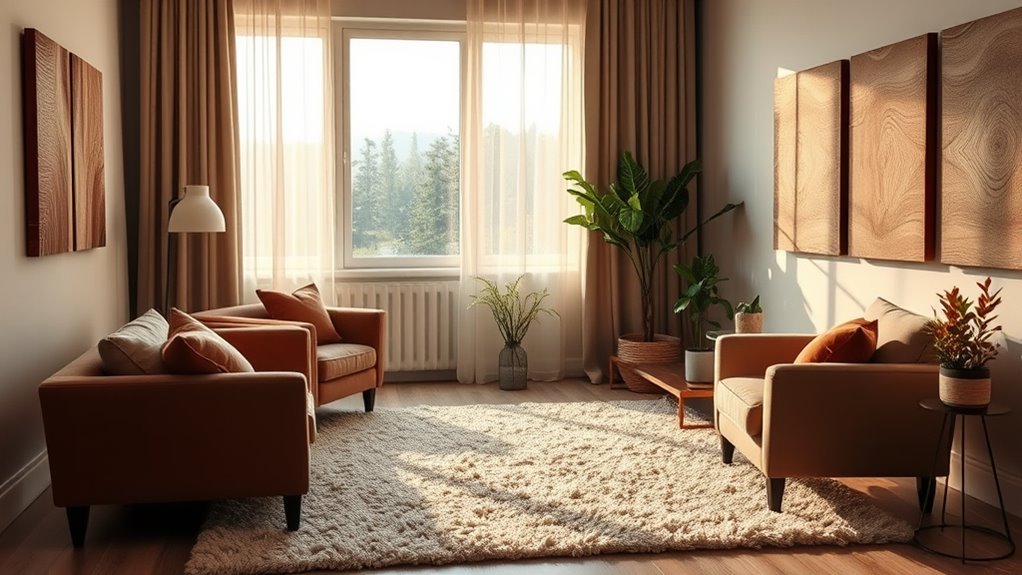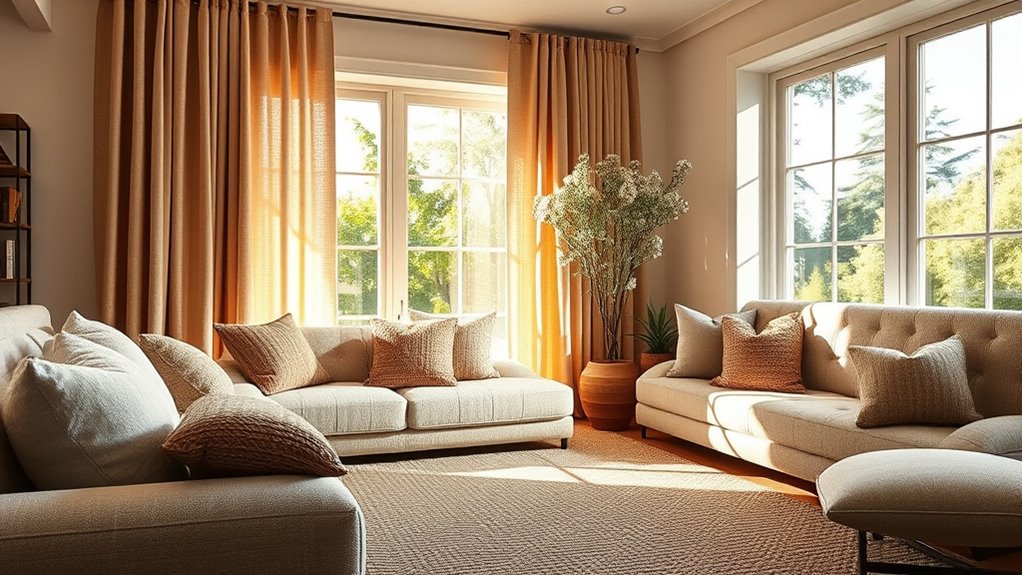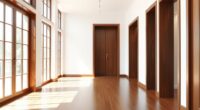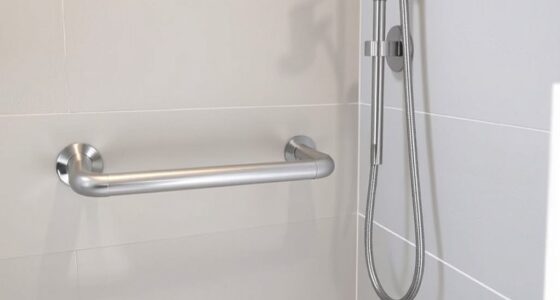To create a hearing-friendly home, focus on optimizing acoustics with soft materials like rugs, curtains, and upholstered furniture that absorb sound and lessen echoes. Organize your space to reduce clutter, which can cause unpredictable reflections. Design quiet zones with sound-absorbing panels and soft furnishings, and add weatherstripping to windows and doors to block outside noise. Using strategic furniture placement and textiles can make your home much more comfortable—you’ll discover simple tips to improve sound clarity just ahead.
Key Takeaways
- Use soft furnishings like rugs, curtains, and upholstered furniture to absorb sound and reduce echoes.
- Incorporate acoustic panels or tiles in key areas to improve sound clarity and minimize background noise.
- Design quiet zones with sound-absorbing materials and strategic furniture placement for focused relaxation or conversation.
- Organize space to reduce clutter and scattered objects that cause unpredictable sound reflections.
- Install weatherstripping on doors/windows and add outdoor barriers to block external noise and enhance home tranquility.

Creating hearing-friendly home can considerably improve your daily life, especially if you or someone in your household has hearing challenges. When your environment is thoughtfully designed, it becomes easier to communicate, stay connected, and enjoy your space without unnecessary frustration. One of the most effective ways to achieve this is by paying attention to acoustics. Hard surfaces like bare floors, tile, and glass can create echoes and amplify background noise, making it harder to hear clearly. To counter this, you can introduce soft materials that absorb sound, such as area rugs, curtains, and upholstered furniture. These elements help reduce reverberation and create a calmer auditory environment. Positioning furniture strategically can also break up sound waves, preventing them from bouncing around the room excessively. Additionally, consider using sound-absorbing wall panels or acoustic tiles in rooms where clarity is most important, like the living room or home office.
Textiles play a essential role in managing sound within your home. Heavy drapes or curtains not only block outside noise but also dampen echoes indoors. Adding throw pillows and plush cushions to sofas and chairs further absorbs sound and enhances comfort. When choosing bedding or upholstery, opt for fabrics that are thick and textured, as these tend to be better at muffling noise. You might also invest in upholstered headboards or fabric-covered wall panels. These textiles don’t just improve acoustics—they also add warmth and a cozy feel to your space, making it more inviting and less sterile. Keep in mind that cluttered spaces with lots of small, hard objects can scatter sound waves, creating unpredictable echoes. Organizing your belongings and maintaining a tidy space can contribute to a more controlled acoustic environment. Moreover, understanding the importance of acoustics can help you make more informed decisions when designing your home’s soundscape.
Creating quiet zones within your home gives you designated spaces for relaxation or focused activities without disruptive noise. These zones can be as simple as a corner with sound-absorbing panels or a room with minimal hard surfaces. Use soft furnishings and textiles in these areas to further dampen sound. If noise from outside is an issue, consider installing weatherstripping on doors and windows, or adding outdoor barriers like shrubs or fences to block out street noise. For shared spaces, establish common rules about noise levels during certain times, like quiet hours in the evening. These zones serve as sanctuaries where conversations can be clearer, and concentration is easier. By intentionally designing these quiet areas, you make everyday life more manageable and enjoyable, especially for those with hearing difficulties. Overall, combining good acoustics, textiles, and designated quiet zones creates a home that’s not only more comfortable but also more accessible and supportive for everyone living in it.
Frequently Asked Questions
How Can I Identify if My Home Has Poor Acoustics?
You can tell if your home has poor acoustics if you notice constant echoes, muffled sounds, or difficulty hearing conversations clearly. If noise bounces around, making it hard to focus or relax, that’s a sign. You might also feel strained listening to background noises or notice that certain rooms seem noisier than others. These issues indicate your home’s acoustics could benefit from improvements like adding textiles or sound-absorbing materials.
What Are the Best Materials for Sound Absorption in Living Spaces?
A quiet home is like a peaceful pond. To attain this, you should choose soft, porous materials like acoustic panels, thick carpets, and heavy drapes. These materials absorb sound waves, reducing echo and noise. Additionally, incorporating textiles such as upholstered furniture or plush rugs can help. Remember, “A stitch in time saves nine,” so adding these sound-absorbing elements now guarantees a calmer, more comfortable living space.
How Can I Create Effective Quiet Zones in a Busy Household?
You can create effective quiet zones by choosing a dedicated space away from household activity, adding soundproofing elements like thick curtains, rugs, and wall panels, and using soft furnishings to absorb noise. Encourage family members to respect the area during designated times, and consider installing door seals or weatherstripping to minimize sound leaks. Keep electronics and noisy devices outside the quiet zone to maintain a peaceful environment.
Are There Specific Furniture Choices That Improve Room Acoustics?
Yes, you can improve room acoustics with specific furniture choices. Opt for soft, upholstered pieces like sofas and armchairs that absorb sound. Add bookshelves filled with books to break up sound waves, and choose plush rugs to reduce echo. Incorporate fabric-covered ottomans or cushions to further dampen noise. These furniture selections create a warmer, quieter environment, making conversations clearer and reducing overall noise levels in your home.
How Does Background Noise Affect Mental Health and Concentration?
Background noise is like a constant buzzing in your ears, making it hard to focus and increasing stress. It can lead to feelings of frustration, anxiety, and even impact your sleep quality. When noise levels are high, your mental clarity drops, and you’re more prone to mistakes. To protect your well-being, create quiet zones and reduce ambient sounds, helping you stay calm, focused, and mentally healthy.
Conclusion
By now, you see how thoughtful acoustics, cozy textiles, and quiet zones can transform your home into a hearing-friendly haven. Don’t you deserve a space where every sound is comfortable, not overwhelming? With a few simple changes, you can enjoy peaceful moments and clear conversations without stress. Why settle for noise and chaos when your home can be a sanctuary of calm? Start making your space more hearing-friendly today—you’ll thank yourself every time you enter.









